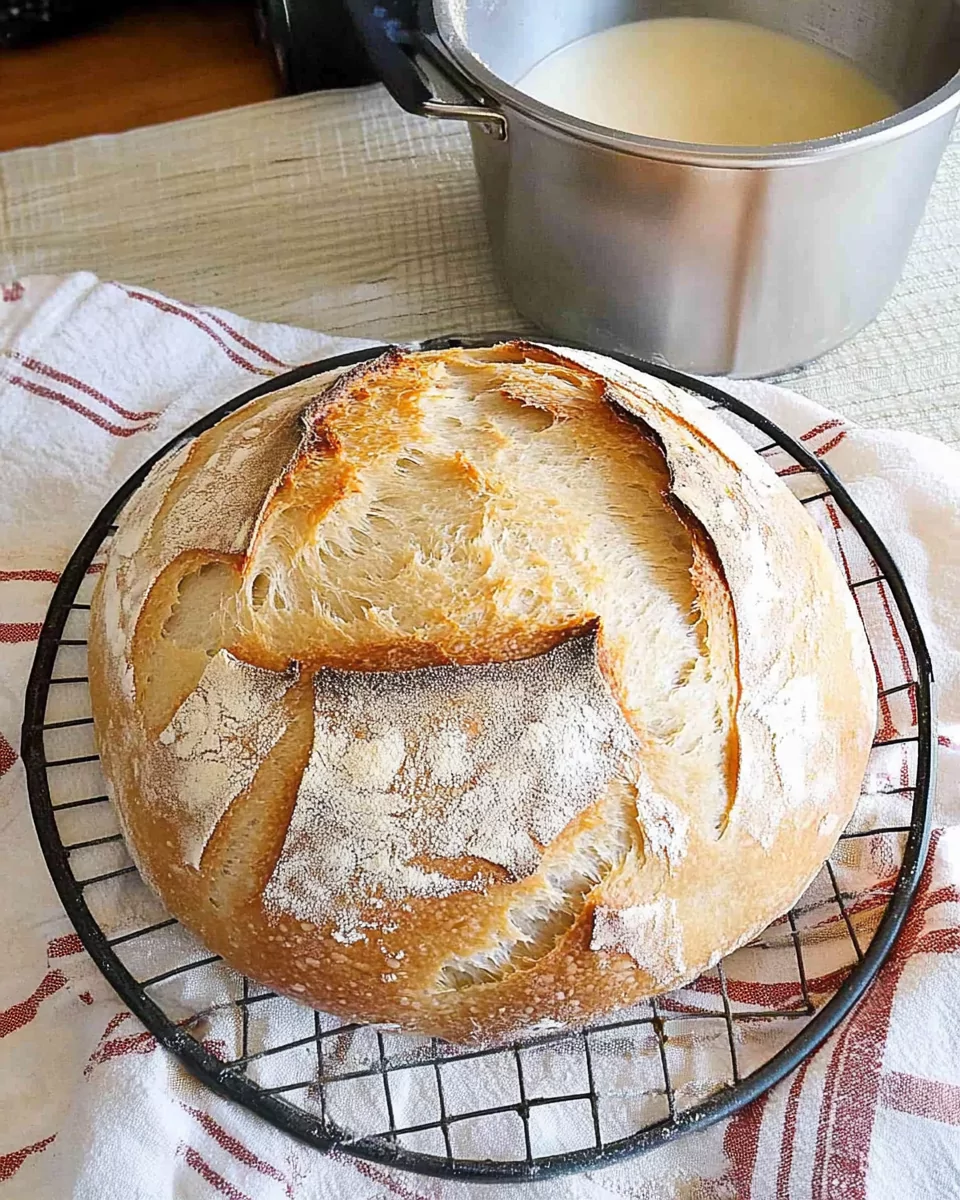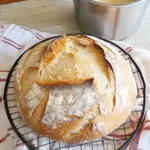The irresistible aroma of freshly baked sourdough bread—without the wait!

This same-day sourdough bread recipe delivers a delicious, crusty loaf in just hours, making it ideal for busy schedules. Whether you’re craving a hearty slice for breakfast or need a showstopper for dinner, this recipe ensures you don’t sacrifice flavor or texture. With a beautifully golden crust and soft interior, it’s the perfect combination of speed and taste.
Why You’ll Love This Recipe
- Quick preparation: Enjoy fresh sourdough in one day.
- Classic sourdough flavor: Achieve tangy, rich notes with minimal effort.
- No overnight fermentation required: Perfect for last-minute baking.
- Versatile and adaptable: Works for sandwiches, toast, or standalone snacking.
Preparation Phase & Tools to Use
Essential Tools and Equipment
- Large Mixing Bowl: For combining and mixing ingredients.
- Dutch Oven: Creates the perfect steam environment for a crusty loaf.
- Bread Lame or Sharp Knife: Ensures precise scoring for beautiful patterns.
- Bench Scraper: Helps with shaping the dough.
- Tea Towel or Banneton Basket: For proofing and retaining the dough’s shape.
- Parchment Paper: Prevents sticking during baking.
Importance of Each Tool
- Mixing Bowl: Accommodates the dough’s expansion during fermentation.
- Dutch Oven: Traps steam, giving the bread a professional bakery-style crust.
- Bread Lame: Allows controlled expansion during baking for consistent results.
- Bench Scraper: Aids in shaping and transferring sticky dough.
- Banneton Basket or Tea Towel: Maintains the dough’s structure during proofing.
Preparation Tips
- Use a kitchen scale for precise measurements to ensure perfect texture.
- Ensure your sourdough starter is active and bubbly for optimal rise.
- Keep your workspace lightly floured to prevent sticking but avoid over-flouring.
Ingredients
- 410 grams all-purpose flour
- 290 grams water
- 160 grams sourdough starter (active and bubbly)
- 8 grams salt
Step-by-Step Directions
1. Mix Ingredients
- In a large mixing bowl, combine the water, sourdough starter, and salt.
- Stir until the starter and salt dissolve evenly.
- Add the flour, mixing with a spoon or your hands until fully combined.
- Scrape down the sides to form a cohesive dough.
- Cover the bowl with plastic wrap or a damp tea towel and let the dough rest for 30 minutes.
2. Stretch and Folds
- Perform the first set of stretch and folds:
- Grab one edge of the dough, gently stretch it upward, and fold it over itself.
- Rotate the bowl 90° and repeat, completing 4 folds in total.
- Cover the dough and rest for 20 minutes.
- Repeat the process for 4 total sets over the course of 1 hour, keeping the dough covered between sets.
3. Bulk Fermentation
- Once stretch and folds are complete, cover the dough again and let it rise at room temperature for 3–4 hours.
- The dough should nearly double in size.
4. Shape the Dough
- Lightly flour a clean surface and transfer the dough onto it.
- Shape the dough into a smooth ball:
- Stretch opposite ends, fold them over the center, and repeat with the remaining sides.
- Pinch the seams at the bottom to create tension on the surface.
5. Final Proof
- Line a banneton basket or bowl with a lightly floured tea towel.
- Place the dough ball inside, seam-side up.
- Cover with a plastic bag or cloth and proof at room temperature for 2 hours.
6. Preheat the Oven
- During the final hour of proofing, preheat the oven to 460°F (238°C).
- Place the Dutch oven inside to ensure it’s thoroughly heated.
7. Score and Bake
- Gently flip the dough onto parchment paper so the floured bottom becomes the top.
- Use a bread lame or sharp knife to score the dough in a crisscross pattern or as desired.
- Transfer the dough (on the parchment paper) into the preheated Dutch oven.
- Add a splash of water between the parchment and the Dutch oven for steam.
- Cover with the lid and bake for 30 minutes at 460°F (238°C).
- Remove the lid and reduce the heat to 440°F (227°C). Bake for another 10 minutes until the crust is golden brown.
8. Cool
- Remove the bread from the oven and transfer it to a cooling rack.
- Cover with a damp kitchen towel and let it cool completely—at least 1 hour—before slicing.
Now that you’ve mastered the bread, it’s time to explore how to serve it, avoid common pitfalls, and pair it with the perfect side dishes. This section provides detailed guidance to help you perfect the recipe and make the most of your homemade loaf.
Serving Suggestions
Freshly baked sourdough bread is versatile and works in countless dishes. Here are some ideas to get you started:
- Classic Toast: Spread with butter, jam, or avocado for a quick snack.
- Gourmet Sandwiches: Layer with deli meats, cheeses, and vegetables.
- Soup Companion: Serve alongside creamy tomato soup or hearty stews.
- Cheese Board: Pair with artisan cheeses, cured meats, and fresh fruits.
- Rustic Bruschetta: Top with diced tomatoes, basil, and olive oil.
- Bread Bowl: Hollow out the center and fill it with chowder or chili.
- Sweet Treat: Dust with cinnamon and sugar, then drizzle with honey.
Common Mistakes to Avoid & How to Perfect the Recipe
Mistakes to Watch For
- Using an Inactive Starter:
- Result: Poor rise and dense texture.
- Solution: Ensure your starter is bubbly and active before use. Feed it 4–6 hours before starting the recipe.
- Overproofing the Dough:
- Result: Collapsed loaf or weak structure.
- Solution: Use the “poke test” during proofing. The dough should spring back slowly when poked.
- Skipping the Stretch and Folds:
- Result: Lack of structure and uneven crumb.
- Solution: Perform all 4 sets of folds to build strength in the dough.
- Not Preheating the Dutch Oven:
- Result: Inconsistent crust and uneven baking.
- Solution: Always preheat the Dutch oven for at least 30 minutes.
- Slicing While Hot:
- Result: Gummy texture and squished slices.
- Solution: Let the bread cool for at least 1 hour to set the crumb.
Side Dish Recommendations
1. Creamy Tomato Soup
The tangy flavor of sourdough perfectly complements the richness of a warm, creamy tomato soup. Dip slices into the soup for a comforting meal.
2. Garlic Herb Butter Spread
Create a quick garlic herb butter by mixing softened butter with minced garlic, parsley, and a pinch of salt. Spread it over warm slices for a delightful appetizer.
3. Mediterranean Hummus Platter
Serve sourdough with an assortment of hummus, olives, and roasted red peppers for a Mediterranean-inspired treat.
4. Cheese Fondue
Cubed sourdough pairs beautifully with melted cheese fondue, creating a decadent and interactive dining experience.
5. Hearty Chili or Stew
Pair your bread with a robust chili or beef stew. The crusty slices are perfect for soaking up rich, flavorful sauces.
6. Smoked Salmon and Cream Cheese
Top toasted slices with cream cheese, smoked salmon, and capers for a luxurious brunch option.
7. Fresh Garden Salad
Lighten the meal by serving sourdough with a crisp, fresh salad dressed with lemon vinaigrette.
8. Nutella and Banana
For a sweet twist, slather slices with Nutella and add banana slices. It’s a simple yet indulgent treat!
ou’ve baked a perfect loaf, served it with style, and now it’s time to make the most of any leftovers. This section covers storage, reheating tips, and answers to common questions about sourdough bread.
Recipe Tips, Storage, and Reheating Instructions
Recipe Tips for Success
- Monitor Room Temperature:
- Cooler rooms may slow fermentation, while warmer ones speed it up. Adjust proofing times as needed.
- Hydration Adjustment:
- If your dough feels too sticky, lightly flour your hands instead of adding more flour to the dough.
- Experiment with Scoring:
- Get creative with your bread lame to make decorative patterns on the crust.
How to Store Sourdough Bread
- At Room Temperature:
- Place the loaf in a bread bag or wrap it in a clean kitchen towel. Store it at room temperature for up to 2–3 days.
- In the Freezer:
- Slice the bread and freeze individual pieces in an airtight bag or container. This allows you to thaw only what you need.
- Avoid Refrigeration:
- The refrigerator can dry out bread and alter its texture.
Reheating Instructions
- For Slices:
- Toast slices in a toaster or skillet for a quick refresh.
- For Whole Loaves:
- Preheat your oven to 350°F (175°C). Wrap the loaf in foil and heat for 10–15 minutes.
- To Revive Crustiness:
- Remove the foil in the last 5 minutes of reheating for a crispy crust.
Frequently Asked Questions (FAQs)
Q: Can I make this recipe with whole wheat flour?
A: Yes! Substitute up to 50% of the all-purpose flour with whole wheat flour. Note that whole wheat flour absorbs more water, so adjust hydration as needed.
Q: What if my sourdough starter isn’t very bubbly?
A: Feed your starter with equal parts flour and water, then let it rest in a warm spot for 4–6 hours before using it in the recipe.
Q: How can I tell if my dough is overproofed?
A: Overproofed dough will collapse or deflate when touched. To avoid this, keep an eye on the dough’s rise and perform the poke test to check readiness.
Q: Can I use a different type of baking vessel if I don’t have a Dutch oven?
A: Yes! You can use a heavy pot with a lid, a cast iron skillet with an inverted baking tray, or even a baking stone with steam added to the oven.
Q: Why is my bread dense instead of airy?
A: This could be due to an inactive starter, insufficient stretch and folds, or overproofing. Ensure each step is followed accurately for best results.
Q: Can I add mix-ins like seeds or nuts to this recipe?
A: Absolutely! Add seeds, nuts, or dried fruit during the first set of stretch and folds to incorporate them evenly.
Q: How do I know if my bread is fully baked?
A: Tap the bottom of the loaf—it should sound hollow. Alternatively, use a thermometer; the internal temperature should read 200–205°F (93–96°C).
Conclusion
Congratulations—you’ve baked, served, and mastered this Speedy Same Day Sourdough Bread Recipe! With its crispy crust, tender crumb, and tangy flavor, this bread is a testament to the joys of homemade baking. Whether you’re a first-time sourdough baker or a seasoned pro, this recipe is sure to become a staple in your kitchen.
Enjoy your sourdough journey, one delicious slice at a time!
For more bread recipes and tips, explore our other guides and resources here.
Speedy Same Day Sourdough Bread Recipe
Ingredients
- 410 grams all-purpose flour
- 290 grams water
- 160 grams sourdough starter
- 8 grams salt
Instructions
Mix Ingredients:
- In a large bowl, combine water, sourdough starter, and salt. Stir well to disperse the starter and salt evenly. Add the flour and mix until combined. Finish mixing with your hands to ensure all the flour is incorporated. Cover with an airtight material (plastic wrap, foil, or even a shower cap) and let the dough rest for 30 minutes.
Stretch and Folds:
- After 30 minutes, perform the first set of stretch and folds:
- Grab the edge of the dough, stretch it upward, and fold it under the opposite side.
- Rotate the bowl 90° and repeat, completing 4 folds in total.
- Cover the dough and let it rest for 20 minutes before repeating.
- Perform 4 total sets of stretch and folds over the course of 1 hour, covering the dough between sets to prevent it from drying out.
Bulk Fermentation:
- Once the stretch and folds are complete, cover the dough again and let it rise for 3–4 hours at room temperature, or until it nearly doubles in size.
Shape the Dough:
- Transfer the dough to a lightly floured surface. Shape it by grabbing opposite ends of the dough and pinching them together at the top. Repeat with the other two ends to form a tight, smooth ball.
Final Proof:
- Prepare a bread or banneton basket by lining it with a lightly floured tea towel. Place the dough ball into the basket, seam-side up. Cover with a plastic bag or cloth and let it rise for 2 hours at room temperature.
Preheat the Oven:
- During the final hour of proofing, preheat your oven to 460°F (238°C) with the dutch oven inside to ensure it is hot.
Score and Bake:
- Once proofed, transfer the dough to a piece of parchment paper, flipping it so the floured bottom becomes the top. Score the dough with a bread lame or sharp knife, creating a crisscross pattern.
- Carefully place the dough (with the parchment paper) into the preheated dutch oven. Add a splash of water between the parchment paper and the dutch oven to create steam. Cover with the lid and bake for 30 minutes at 460°F (238°C).
- Remove the lid and bake for an additional 10 minutes at 440°F (227°C) to achieve a golden-brown crust.
Cool:
- Remove the bread from the oven and transfer it to a cooling rack. Cover with a damp kitchen towel and let it cool for at least 1 hour before slicing.
Notes
Signs of Proper Proofing:
The dough should double in size.
Perform a “poke test”: when you press the dough, the indentation should slowly fill back in.




I made this today and it the best sourdough bread I have ever made. The crust is perfect and the amount of holes is amazing. This recipe will be repeated often. It also has the best sourdough flavor. I use a started from King Arthur that is very active.
That’s amazing to hear 🥳. Enjoy the recipe, and thanks for sharing your feedback!